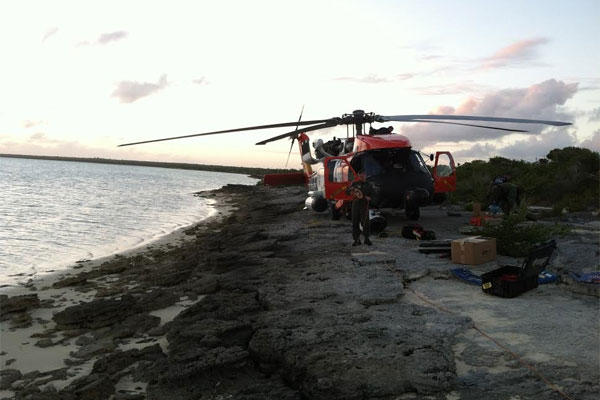The operations the Coast Guard performs in the Bahamas, Turks and Caicos – or OPBAT – are demanding and critical in halting drug and migrant smuggling activity. So when something unexpected happens, the crew must pull together to remedy any situation that comes their way. This is exactly what Coast Guard Air Station Clearwater crewmembers did when they were forced to perform a precautionary landing on the southern shore of Mayaguana Island, Bahamas, just three feet from the waters edge.
During a law enforcement patrol on Dec. 9, an Air Station Clearwater MH-60 Jayhawk helicopter crew performed a precautionary landing after they reported hearing an unfamiliar, high-pitched, grinding sound from the forward section of the number two engine.
“When a helicopter crew makes a precautionary landing, it is always for the safety of the crew,” said Chief Warrant Officer Matthew Kellison, the OPBAT maintenance officer at the air station. “The noise they heard was serious enough for the pilot to make the decision to land immediately in the best interest of all aboard.”
Just hours later, a deployed Clearwater maintenance crew from Great Inagua arrived on-scene, coordinated a security watch due to the desolate area, and completed a thorough inspection by means of a boroscope. A boroscope is a small camera devise that can be snaked inside the engine to assess any damage. It was reported that the number two engine had been damaged and required replacement.
Without delay, deployed crews from Great Inagua and Air Station Clearwater began coordinating the transport of a replacement engine, additional tools, equipment and personnel via an HC-130 Hercules airplane, from Clearwater to Great Inagua.
“It was amazing to see the deployed crews, crews here at the air station and the great work from the supply department come together and coordinate what was needed to get the equipment and engine on a plane to the site the very next morning,” said Kellison. “It was an outstanding team effort from all.”
The air crew aboard the Hercules arrived in Matthew Town, Great Inagua, on Dec. 10 with the essential cargo load; Coast Guard personnel off-loaded the cargo and began to plan the logistics of transporting all personnel, tools and equipment, including the 700-pound replacement engine, to the rocky shoreline of Mayaguana Island.
The following day, two deployed Jayhawk helicopter crews from Great Inagua, one from Coast Guard Air Station Elizabeth City, N.C., and one from Air Station Clearwater, began ferrying maintenance personnel, tools and equipment 90 miles northeast to Mayaguana.
“Utilizing the external load capabilities of the Jayhawk, the crew sling loaded the replacement engine to Mayaguana Island’s rocky shoreline, placing the engine inches away from damaged helicopter,” said Kellison.
Sling loading the engine means it was flown 90 miles from Great Inagua to the site 70 feet below the helicopter the entire distance, he said.
With a level platform made, and all equipment in reach, maintenance personnel removed the damaged engine and began working on the installation of the new engine. As daylight drew to a close, the site was cleaned up, tools were inventoried and the maintenance crew was transported back to Matthew Town for the night.
A 24-hour security watch was maintained throughout the night by two Coast Guard members with assistance from partnering agents of the Drug Enforcement Agency and Bahamian Drug Enforcement Unit. They took shifts ensuring the safety and security of the personal and aircraft at an unsecured site in the middle of nowhere said Kellison.
“I really can’t say enough good things about these guys and the great assistance they provided,” said Lt. Mike Carroll, the Jayhawk engineering officer at the air station. “The interagency partnerships we have are phenomenal.”
Maintenance and repairs were completed Dec. 12 and a thorough preflight was conducted. The repaired Jayhawk was flown back to Great Inagua safely with all crew aboard by sunset.
“This is one of those once in a decade challenges that come with operations in remote parts of the Caribbean. I couldn’t be any more proud of my folks for such an amazing repair under such demanding condition. They really pulled together as a team to recover that aircraft,” said Capt. Richard Lorenzen, commanding officer of the air station.























